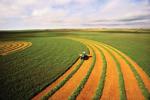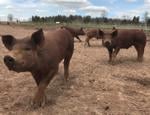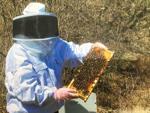The biannual Agricultural Labor Survey will start this month. The survey will collect information about hired labor from more than 4,000 farmers and ranchers across the 11-state Northeast region.
The beginning of the year is the time when agricultural producers plan out the rest of their growing seasons, and it is a great time to assess on-farm labor needs.
The data that farm operators provide for this National Agricultural Statistics Service survey allow federal policymakers to base farm labor policies on accurate information. USDA and the U.S. Department of Labor use statistics gathered in the survey to establish minimum wage rates for agricultural workers, administer farm labor recruitment and placement service programs, and assist legislators in determining labor policies.
In the survey, participants are asked to answer a variety of questions about hired farm labor on their operations, including total number of hired farm workers, the total hours worked, and total base and gross wages paid for the weeks of Jan. 10-16 and April 11-17. Survey participants can respond online at agcounts@usda.gov or by mail.
By asking about two separate time periods each time we collect data during the year, we are able to publish quarterly data and capture seasonal variation. This approach reduces the number of times we survey farm businesses while ensuring that accurate and timely data are available. NASS will compile, analyze and publish survey results in the May 26 farm labor report.
For more information on NASS surveys and reports, call the Northeastern Regional Field Office at 800-498-1518.
Prospective Plantings Report
U.S. corn growers intend to plant 91.1 million acres in 2021, up less than 1% from last year, according to the prospective plantings report released March 31.
Planted acreage for 2021 is expected to be up or unchanged from 2020 in 24 of the 48 estimating states. Record high acreage is expected in Idaho and Oregon. Record low acreage is expected in Massachusetts and Rhode Island. Acreage increases from last year of 100,000 acres or more are expected in Louisiana, Mississippi, North Dakota, South Dakota, Tennessee and Wisconsin.
U.S. soybean growers intend to plant 87.6 million acres in 2021, up 5% from last year. Compared with last year, planted acreage intentions are up or unchanged in 23 of the 29 estimating states. Increases of 250,000 acres or more are anticipated in Illinois, Iowa, Minnesota, Nebraska, North Dakota, South Dakota and Wisconsin. If realized, the planted area in Kentucky, Pennsylvania, South Dakota and Wisconsin will be the largest on record.
Area expected to be seeded to oats for the 2021 crop year is estimated at 2.49 million acres, down 17% from 2020. If realized, the United States planted area will be the second lowest on record. Record low planted acreage is expected in Oregon, Pennsylvania and Texas.
U.S. barley producers intend to seed 2.59 million acres of barley for the 2021 crop year, down 1% from the previous year. If realized, this will represent the fourth lowest planted acreage on record. A record low planted acreage is estimated for California, Minnesota, New York,and Wisconsin.
The prospective plantings report provides the first official, survey-based estimates of U.S. farmers’ 2021 planting intentions. NASS’s acreage estimates are based on surveys conducted during the first two weeks of March from a sample of approximately 78,900 farm operators across the United States.
Key findings in the Northeastern states are:
Delaware
Corn planted area for all purposes is estimated at 170,000 acres, down 6% from last year. Soybean planted area is estimated at 165,000 acres, up 10% from the previous year. Barley planted area is estimated at 21,000 acres, unchanged from the previous year. Winter wheat area planted is estimated at 60,000 acres, down 20% from last year. Hay area harvested is estimated at 14,000 acres, unchanged from the previous year.
Maryland
Corn planted area for all purposes is estimated at 470,000 acres, down 2% from last year. Soybean planted area is estimated at 480,000 acres, down 1% from the previous year. Barley planted area is estimated at 35,000 acres, up 3% from 2020. Winter wheat area planted is estimated at 330,000 acres, down 7% from the previous year. Hay area harvested is estimated at 210,000 acres, up 5% from the previous year.
New England
Corn planted for Massachusetts, New Hampshire and Rhode Island are unchanged from the previous year, but up for Connecticut and down for Maine and Vermont.
Connecticut corn planted area for all purposes is estimated at 26,000 acres. Maine corn planted area for all purposes is estimated 27,000 acres. Massachusetts corn planted area for all purposes is estimated at a record low 14,000 acres. New Hampshire corn planted area for all purposes is estimated at 13,000 acres. Rhode Island corn planted area for all purposes is estimated at a record low 2,000 acres. Vermont corn planted area for all purposes is estimated at 81,000 acres.
Maine oat planted area for all purposes is estimated at 23,000 acres, down 12% from the previous year.
Connecticut hay area harvested is estimated at a record low 45,000 acres, down 2% from last year. Maine hay area harvested is estimated at 104,000 acres, unchanged from the previous year. Massachusetts hay area harvested is estimated at 68,000 acres, up 13% from last year. New Hampshire hay area harvested is estimated at 50,000 acres, up 19% from the previous year. Rhode Island hay area harvested is estimated at 5,000 acres, unchanged from the previous year. Vermont hay area harvested is estimated at 165,000 acres, down 1% from last year.
New Jersey
Corn planted area for all purposes is estimated at 85,000 acres, down 2% from the previous year. Soybean planted area is estimated at 105,000 acres, up 12% from last year. Winter wheat area planted is estimated at 23,000 acres, down 8% from last year. Hay area harvested is estimated at a 110,000 acres, up 4% from the previous year.
New York
Corn planted area for all purposes is estimated at 1.05 million acres, unchanged from previous year. Soybean planted area is estimated at 330,000 acres, up 5% from 2020.
Oat planted area is estimated at 47,000 acres, down 10% from the previous year. Winter wheat area planted is estimated at 150,000 acres, unchanged from the previous year.
Hay area harvested is estimated at 1.08 million acres, up 2% from the previous year.
New York producers intend to seed 9,000 acres of barley for the 2021 crop year, the same as the previous year.
Pennsylvania
For the 2021 crop season, growers across the state intend to plant an estimated 640,000 acres of soybeans in 2021, unchanged from 2020. Corn planted area for all purposes is estimated at 1.48 million acres, down 1% from last year.
Barley planted area is estimated at 39,000 acres, down 13% from the previous year. Oat planted area is estimated at 65,000 acres, down 24% from last year. Winter wheat area planted is estimated at 250,000 acres, up 6% from last year.
Hay area harvested is estimated at 1.35 million acres, unchanged from the previous year.
Tobacco harvested area is estimated at 3,800 acres, down 31% from last year.
Hogs and Pigs Inventory Down Nationally
As of March 1, there were 74.8 million hogs and pigs on U.S. farms, down 2% from March 2020, and down 3% from Dec. 1, 2020, according to the quarterly hogs and pigs report published March 25.
Pennsylvania inventory of all hogs and pigs on March 1 was 1.35 million head. This was the same as March 1, 2020 and down 3% from Dec. 1, 2020. Breeding inventory, at 140,000 head, was down 7% from March 1, 2020 and from the previous quarter. Market hog inventory, at 1.21 million head, was up 1% from last year, but down 2% from previous quarter.
During the first half of March 2021, data were collected from about 3,200 operations, 65.6% of the total sample.
U.S. Honey Production Down 6%
Nationwide, there were 2.71 million colonies producing honey in 2020, down 4% from the previous year. Honey production totaled 148 million pounds, down 6% from 2019. Yield per colony averaged 54.5 pounds, down 2% from the 55.8 pounds in 2019. Producer honey stocks were 39.7 million pounds on Dec. 15, 2020, down 3% from a year earlier. The U.S. honey crop price increased during 2020 to $2.03 per pound, up from the $1.99 per pound in 2019.
Five states in the Northeast region for published honey production are Maine, New Jersey, New York, Pennsylvania and Vermont. Connecticut, Delaware, Maryland, Massachusetts, New Hampshire, and Rhode Island were published with Alaska, Nevada, New Mexico and Oklahoma as other states to avoid disclosing data for individual operations if published separately.
Honey production in 2020 from Maine producers with five or more colonies totaled 300,000 pounds, down 43% from 2019. There were 10,000 colonies producing honey in 2020, down 33% from a year earlier. Yield per colony averaged 30 pounds, down 14% from 2019. Honey prices decreased during 2020 to $3.26 per pound, down 1% from $3.28 per pound in 2019. Producer honey stocks were 78,000 pounds on Dec. 15, 2019, down 29% from a year earlier.
Honey production in 2020 from Vermont producers with five or more colonies totaled 282,000 pounds, down 2% from 2019. There were 6,000 colonies producing honey in 2020, unchanged from 2019. Yield per colony averaged 47 pounds, down 2% from 2019. Honey prices decreased during 2020 to $3.76 per pound, down 16% from $4.48 per pound in 2019. Producer honey stocks were 96,000 pounds on Dec. 15, 2020, up 14% from a year earlier.
Honey production in 2020 from New Jersey producers with five or more colonies totaled 434,000 pounds, up 3% from the previous year. There were 14,000 colonies producing honey in 2020, down 7% from a year earlier. Yield per colony averaged 31 pounds, up 11% from 2019. Producer honey stocks were 91,000 pounds on Dec. 15, 2020. Honey prices increased during 2020 to $7.99 per pound, up 71% from $4.68 per pound in 2019.
Honey production in 2020 from New York producers with five or more colonies totaled 3.25 million pounds, down 5% from 2019. There were 58,000 colonies producing honey in 2020, down 2% from 2019. Yield per colony averaged 56 pounds, down 3% from the 58 pounds in 2019. Producer honey stocks were 844,000 pounds on Dec. 15, 2020, down 18% from a year earlier. Honey prices decreased during 2020 to $3.39 per pound, down 15% from $4 per pound in 2019.
Honey production in 2020 from Pennsylvania producers with five or more colonies totaled 912,000 pounds, down 4% from 2019. There were 19,000 colonies producing honey in 2020, unchanged from 2019. Yield per colony averaged 48 pounds, down 4% from the 50 pounds in 2019. Producer honey stocks were 392,000 pounds on Dec. 15, 2020, down 4% from a year earlier. Honey prices increased during 2019 to $4.74 per pound, up 7% from $4.41 per pound in 2019.
Do You Use the Internet?
If so, you could serve agriculture by describing crop conditions in your county. During the growing season, we only ask that you tell us about the condition of crops that you are already familiar with.
To learn more, visit our website and click on the “Help Wanted” button.
To Growers
I would like to thank you for your contribution to U.S. agriculture and support of our programs. I hope you will continue to support NASS by returning your survey form as soon as possible or answering our questions over the telephone or if someone comes to visit.
Be assured, as with all NASS surveys, the information respondents provide is confidential by law. NASS safeguards the privacy of all responses and publishes only state- and national-level data, ensuring that no individual operation or producer can be identified. All reports are available on the NASS website at www.nass.usda.gov.
The Link LonkApril 18, 2021 at 05:25PM
https://ift.tt/3go5Udi
USDA Gathering Farm Labor Data | Latest News for Corn, Soybeans, Wheat and more | lancasterfarming.com - Lancaster Farming
https://ift.tt/3gguREe
Corn




No comments:
Post a Comment